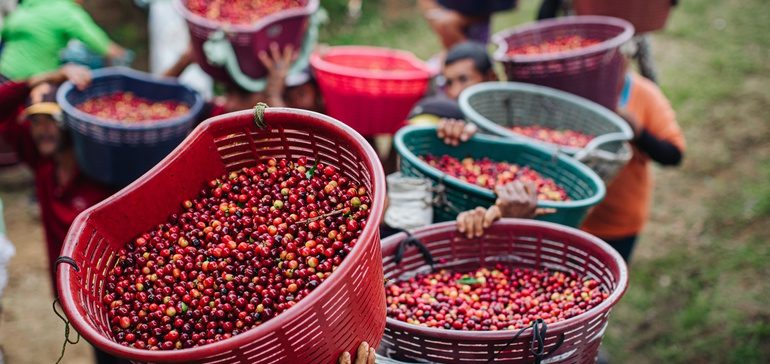Organizations partner to create fair-pricing model for coffee growers

Dive Brief:
-
Commercial coffee roaster Bellweather Coffee, global development organization Heifer International and specialty coffee importer Sustainable Harvest have launched a new pricing model for the commodity called Verified Living Income, according to a press release.
-
The program helps farmers determine the price they need to receive for their coffee to earn a living wage. Its goal is to equalize power dynamics between buyers and producers, evolve procurement practices to address sustainability and increase cooperation throughout the supply chain.
- There is a growing effort across the industry to provide greater support and transparency for coffee farmers, which often receive little to no profit for their crops.
Dive Insight:
Consumers love coffee with consumption climbing 5% between 2015 and 2020, according to the National Coffee Association’s Atlas of American Coffee. As demand for the brew grows, some stakeholders are calling attention to the low prices that coffee farmers receive.
A few factors contributing to depressed coffee prices include currency devaluation, speculation and an oversupply from large producers in Brazil and Vietnam. A devastating disease called coffee rust leaf also is plaguing some farmers’ crops. Without proper prices, producers facing the disease have a harder time rehabilitating their crops and protecting the long-term economic viability of their farms.
Growers have been trying to call more attention to their economic plight with the hopes of rallying support from consumers and the supply chain. Similar efforts in the cocoa industry to secure better prices have motivated coffee farmers to take a stand. Given that the majority of cocoa production is consolidated in a few countries while coffee production spans the globe may mean that growers of the bean face a steeper uphill battle.
This has not deterred coffee growers from taking action. In 2019, coffee growers in Brazil, Colombia and 24 other countries met in Brazil to discuss potential solutions to depressed prices.
A year earlier, growers from more than 30 countries wrote a letter to more than 20 large coffee buyers, including Nestlé and Starbucks, alerting them to the issue and requesting better prices. Only one company responded to the effort. Nestlé claimed it would need action from several companies throughout the supply chain before it could pay farmers better prices.
Having support from major supply chain stakeholders such as Bellweather, Heifer and Sustainable Harvest could help build momentum for the cause of coffee farmers. An industry-led effort also could assist coffee buyers and manufacturers to identify sourcing opportunities that provide better prices for farmers.
If more coffee buyers adopt the Verified Living Income pricing model, it could create a domino effect that encourages other buyers to follow suit. With shoppers increasingly preferring that brands take strong stances on social justice issues, consumer pressure could help contribute to the momentum.
This is not the first effort to raise awareness for coffee. Fairtrade International offers a certification program to help consumers and other supply chain players connect with coffee farmers and provide them with better prices through a premium.
The organization determined a price of around $2 per pound for coffee would be enough to provide a four-person farming household in Colombia with a living income. At double the current market price, however, this may be a tall order for some coffee companies. The price that farmers earn for their coffee beans has dropped 70% between 2014 and 2020 and now hovers around $1 per pound, according to Green Biz.
Olam Coffee has been taking steps to improve conditions for coffee growers, too. As part of a recent sustainability commitment, it announced plans to train 100,000 households on sustainable agricultural practices and promote vocational agriculture training to 10,000 young people in the next five years. It’s also hoping to increase the sustainability of coffee production in its supply chain.
There is an economic incentive for Olam to invest in these measures. Sustainable coffee sales have doubled since 2016 and now comprise 19% of its total sales as of 2019, according to the company.
Source: fooddive.com

